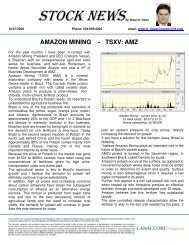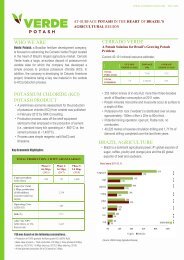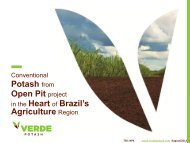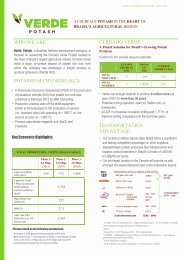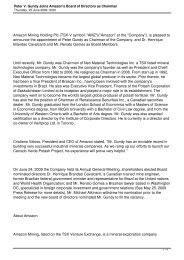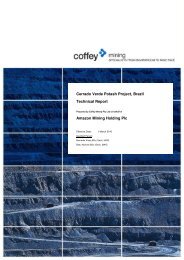Verde Potash heats up on Brazilian thermopotash - Ahead of the Herd
Verde Potash heats up on Brazilian thermopotash - Ahead of the Herd
Verde Potash heats up on Brazilian thermopotash - Ahead of the Herd
Create successful ePaper yourself
Turn your PDF publications into a flip-book with our unique Google optimized e-Paper software.
AUTHORIZEDREPRINTwww.nor<strong>the</strong>rnminer.comAugust 1-7, 2011 • VOL. 97, NO. 24 • SINCE 1915highways clogged with <strong>the</strong> slow-movingmachines.Transportati<strong>on</strong> is also a key part <strong>of</strong><str<strong>on</strong>g>Verde</str<strong>on</strong>g>’s competitive edge compared withimports. Veloso explains that, when localblenders order potash from Saskatchewan,<strong>the</strong>y must wait three m<strong>on</strong>ths for <strong>the</strong>ship to arrive, <str<strong>on</strong>g>up</str<strong>on</strong>g> to a m<strong>on</strong>th more to unload<strong>the</strong> cargo in Brazil’s severely c<strong>on</strong>gestedports, and <strong>the</strong>n haul it by truckanywhere from 600 to 1,000 km inland.Total transportati<strong>on</strong> costs for importsrun from $150 to $200 per t<strong>on</strong>ne, while<str<strong>on</strong>g>Verde</str<strong>on</strong>g> is looking at $20 to $70 per t<strong>on</strong>ne.“Literally being down <strong>the</strong> road fromwhere <strong>the</strong> blenders are in Brazil, immediatelydown <strong>the</strong> road from <strong>the</strong> biggestblending district in Brazil, it just makesit a very simple propositi<strong>on</strong>,” Veloso says.<str<strong>on</strong>g>Verde</str<strong>on</strong>g>’s capital costs also set it apartfrom most potash projects, which <strong>of</strong>tenrun into <strong>the</strong> billi<strong>on</strong>s. A PEA released lastfall estimates capital costs <strong>of</strong> US$196.8milli<strong>on</strong> for a 1.1-milli<strong>on</strong> t<strong>on</strong>ne a year operati<strong>on</strong>,and US$269.4 milli<strong>on</strong> for double<strong>the</strong> output.For <strong>the</strong> smaller, base-case model, operatingcosts are estimated at US$41.80per t<strong>on</strong>ne, with a capital payback in 2.4years. The scenario generates a net presentvalue (NPV) <strong>of</strong> US$455.4 milli<strong>on</strong> ata 10% discount rate, and an after-taxinternal rate <strong>of</strong> return (IRR) <strong>of</strong> 32.9%.A doubled 2.2-milli<strong>on</strong>-t<strong>on</strong>ne opti<strong>on</strong>cuts operating costs by US$5.44 pert<strong>on</strong>ne, payback by half a year, andboosts <strong>the</strong> NPV to US$858.1 milli<strong>on</strong>,and <strong>the</strong> IRR to 40.2%.Veloso says <strong>the</strong> PEA, al<strong>on</strong>g with <strong>the</strong>marketing study, have g<strong>on</strong>e a l<strong>on</strong>g wayin validating <strong>the</strong> Cerrado <str<strong>on</strong>g>Verde</str<strong>on</strong>g> story.“We had big expectati<strong>on</strong>s that itcould be a success, but those were <strong>the</strong>two independent milest<strong>on</strong>es that helpedc<strong>on</strong>firm it,” Veloso says.Down to <strong>the</strong> detailsWith <strong>the</strong> basics established, <str<strong>on</strong>g>Verde</str<strong>on</strong>g> is nowperfecting <strong>the</strong> processing, and provingit’s possible <strong>on</strong> a large scale.For <strong>the</strong> roasting, <str<strong>on</strong>g>Verde</str<strong>on</strong>g> initially c<strong>on</strong>ductedtesting <strong>on</strong> a 100-kg-per-hour facility<strong>on</strong> <strong>the</strong> outskirts <strong>of</strong> Belo Horiz<strong>on</strong>te.Now, it is moving to a 100-t<strong>on</strong>ne-a-dayoperati<strong>on</strong> a little far<strong>the</strong>r out <strong>of</strong> town.John Kaiser <strong>of</strong> Kaiser Research Online— who recommended <str<strong>on</strong>g>Verde</str<strong>on</strong>g> to his readerswhen it traded under 20¢ in 2009— was <strong>on</strong> <strong>the</strong> same site visit, and sees <strong>the</strong>ramp-<str<strong>on</strong>g>up</str<strong>on</strong>g> as <strong>on</strong>e <strong>of</strong> <strong>the</strong> remaining uncertainties.“There are always risks that<strong>the</strong> processdoes not scale <str<strong>on</strong>g>up</str<strong>on</strong>g>cost effectively,”Kaiser says. “What happens to yourresidence times? How l<strong>on</strong>g do you haveto keep a certain volume <strong>of</strong> material in<strong>the</strong> kiln, to get <strong>the</strong> right temperatureand <strong>the</strong> right chemical reacti<strong>on</strong>?”<str<strong>on</strong>g>Verde</str<strong>on</strong>g> has refined <strong>the</strong> process during<strong>the</strong>se trials. Pedro Ladeira, VP <strong>of</strong> engineering,has extensive experience in <strong>the</strong>cement industry, which uses a verysimilar process to what <str<strong>on</strong>g>Verde</str<strong>on</strong>g> plans. Heintroduced an air-mist cooling systemas an alternative to water, as well as usinga powder ra<strong>the</strong>r than pellets in <strong>the</strong> initialstages, with both potentially yielding costsavings in <strong>the</strong> <str<strong>on</strong>g>up</str<strong>on</strong>g>coming prefeasibilitystudy.Capital costs will likely go <str<strong>on</strong>g>up</str<strong>on</strong>g> in <strong>the</strong>next study. Robert Winslow, an analystat Wellingt<strong>on</strong> West who covers <str<strong>on</strong>g>Verde</str<strong>on</strong>g>,writes in a recent note that <strong>the</strong> exchangerate al<strong>on</strong>e is increasing anticipated capitalcosts. Winslow is projecting a capitalcost for <strong>the</strong> 2.2-milli<strong>on</strong>-t<strong>on</strong>ne-peryearoperati<strong>on</strong> <strong>of</strong> US$318 milli<strong>on</strong>. Henotes that <str<strong>on</strong>g>Verde</str<strong>on</strong>g>’s assumpti<strong>on</strong>s includea U.S. dollar to a <strong>Brazilian</strong> real exchangerate <strong>of</strong> 1.8, but <strong>the</strong> real has appreciatedaround 15% against <strong>the</strong> dollar since <strong>the</strong>PEA was released.Winslow writes that any increasedcapital expenditure will likely not be<strong>of</strong>fset by higher fertilizer prices, especiallybecause Thermopotash is a newproduct that hasn’t received governmentcertificati<strong>on</strong>. He has reduced histarget share price for <str<strong>on</strong>g>Verde</str<strong>on</strong>g> to $10.50from $11, but is looking at positive developments,such as an <str<strong>on</strong>g>up</str<strong>on</strong>g>dated resourcefor Cerrado <str<strong>on</strong>g>Verde</str<strong>on</strong>g>, Thermopotashproduct certificati<strong>on</strong> and a resource for<strong>the</strong> company’s Apatita phosphate project.<str<strong>on</strong>g>Verde</str<strong>on</strong>g> could also get a boost when aresource estimate comes out <strong>on</strong> its limest<strong>on</strong>eproject, 100 km away from its Cerrado<str<strong>on</strong>g>Verde</str<strong>on</strong>g> project. The company recentlyreleased drill results from <strong>the</strong>target that showed an average thickness<strong>of</strong> 36 metres grading 53% calcium oxide,and less than 2% silic<strong>on</strong> dioxide. The statisticsfit perfectly with <strong>the</strong> limest<strong>on</strong>erequirements for producing Thermopotashand, like <strong>the</strong> verdete, its proximityis a key benefit.“It’s just ano<strong>the</strong>r industrial material,”Veloso says <strong>of</strong> <strong>the</strong> limest<strong>on</strong>e project.“It’s all about locati<strong>on</strong>.”The new resource at Cerrado <str<strong>on</strong>g>Verde</str<strong>on</strong>g>will come from 26,000 metres <strong>of</strong> drillingthat <str<strong>on</strong>g>Verde</str<strong>on</strong>g> is c<strong>on</strong>ducting to <str<strong>on</strong>g>up</str<strong>on</strong>g>grade <strong>the</strong>resource to indicated. Early results areencouraging.Killer carrotsWith several milest<strong>on</strong>es reached, <str<strong>on</strong>g>Verde</str<strong>on</strong>g>is c<strong>on</strong>vincing investors <strong>of</strong> <strong>the</strong> story’svalidity. The company’s stock priceclimbed from 60¢ in mid-2009, to a high<strong>of</strong> $10.95 in April 2011. But <strong>the</strong> climbhasn’t been easy.“Every time some<strong>on</strong>e tries to dosomething that no <strong>on</strong>e has d<strong>on</strong>e before,every<strong>on</strong>e thinks, oh, it’s not going towork,” Veloso says. “If it could work,why isn’t some<strong>on</strong>e else doing it?”Low potash prices and sated local demandare key reas<strong>on</strong>s it hadn’t beend<strong>on</strong>e, but so was <strong>the</strong> risk <strong>of</strong> trying somethingnew, which was seen when resultsfrom Sekita came out. C<strong>on</strong>ducting “realworld” tests <strong>on</strong> carrot crops, <strong>the</strong> resultswere inc<strong>on</strong>clusive, with similar productivityand quality results using potash,Thermopotash or no fertilizer at all.<str<strong>on</strong>g>Verde</str<strong>on</strong>g> slipped <strong>the</strong> informati<strong>on</strong> at <strong>the</strong>4



